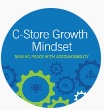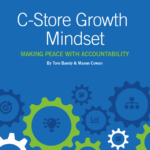
April 25, 2024
The changes and competition in the convenience retail world demands strong operations. Building a brand, having loyal customers and establishing a strong community presence cannot be attained and sustained without reliable operations. The convenience business is about people: your customers and your staff. Your operations determine how well you deliver convenience through your staff to your customers. Understanding five c-store operations drivers and impediments is simple. Keeping the drivers active and removing the impediments, however, takes skill, teamwork, and commitment. Growing operators focus on improving c-store operations in a scalable and reliable way as one of the foundations to long-term success.
C-Store Operations Drivers
1. Achievement

Mike Crowell
Results matter. Operations need to know how they are doing. Managers responsible for their stores need to know how they are doing. Having a basic understanding of the numbers provides a clear picture. Basic information includes key store sales, traffic, fuel, compliance, inventory and customer service. Knowing if things are better or worse with meaningful comparisons lets the manager know if things are better or worse.
Running a store does not allow much time for number crunching so having the key information readily available is a starting point for knowing how things stand and where to focus priorities. Mike Crowell, Operations Director Small & Sons Convenience, found that setting goals and measuring results was the key to focused action. He found that “team building started once we set goals together. Before goals were set, we just found problems, but there was not much resolution. That is, after we started, then the next fire would take over and we would not get our work completed before the next problem took our attention.”
2. Alignment
C-store operations alignment with all managers is a force multiplier. Mason Cowan writes in the C-Store Growth Mindset, that it “leads to astonishing results. It enables a team to achieve performance levels that are far greater than the individual best of the team members. His list of benefits include:

- Shared goals
- Stronger trust
- Time savings
- Faster work
- Increased creativity
- Higher confidence
- More fun
3. Accountability
To achieve a top C-Store performance accountability trust must be strong. In order to operate remote stores well, there must be a level of trust. This trust must be bi-directional. Employees must believe they will have the resources they need for success and HQ staff need remote operations to perform as required. That is why many accountability coaches say, ‘Trust or Bust’. Trust is required by everyone in the organization. Trust is a natural outcome of alignment.
The combination of an objective approach to measure achievement and strong alignment typically makes accountability a natural result. While any sequence of focus can work, the accountability driver often follows improvement with either achievement or alignment. Of course, accurate, meaningful measurements of results along with strong team cohesiveness makes accountability simpler.
Once you know where you are going, the path and the resources become the mechanism to achieve the desired results. When there is a purpose, training is motivated. With the resources of time, skills, facility and product provided, the operations can be performed. Checklists, schedules, and feedback provide the mechanisms to make it clear how to do the work that is needed to achieve the required results. With measurement, performance can be assessed. Finally, with a culture of responsibility and problem solving, change is possible, so employees develop to achieve the results. With a process in place, employees’ ability to execute is simple and specific.
4. Attention
Crowell found that paying attention was the key to making a substantial improvement in his operations. The desire to do better was our key to taking the first step. Sometimes, just picking a place to start is the hardest part. We were never complacent despite havimg lots of operations defects for which we were not happy.
do better was our key to taking the first step. Sometimes, just picking a place to start is the hardest part. We were never complacent despite havimg lots of operations defects for which we were not happy.
- Engage with people
- See the situation
- Be objective
- Appreciate quality
- Address problems
- Consider others
- Understand priorities
5. Aspiration
Looking at what is possible, rather than what is now. As Crowell stated his team started improving as he set goals. Measuring the results provides focus. Mike felt that if his team was not complacent, that is, they wanted to get better, no obstacles could hold them back. His aspiration initially was simply to have a strong operation that allowed his team and himself to enjoy their job. Of course, with success the cycle returns to goals and new and bigger goals are the natural benefit of success.
Mike is not alone in the goal setting. John Doer worked for Andy Grove when he started making computer chips. In his TED talk, he refers to Grove as the ‘greatest manager of all time’. Grove thought goals provided clarity which provide execution guidance. he argued “The objective is the direction. The key results have to be measured, but at the end you can look and without any argument say, “Did I do that, or did I not do that?” Yes. No. Simple. Hence, the desire to be great, the setting of the goal and its measurement make the cycle robust and successful.
C-Store Operations Impediments
1. Complacent

BJ Cooper
Attitude and effort are key hiring traits. BJ Cooper. district manager at JD Streett, summarizes the challenges with complacency when trying to achieve c-store growth: “Going through the motions, or hearing an employee describe their job as ‘I am a cashier at the local gas station, it pays the bills’” is a complacency red flag. A job has to provide income of course, but if the check is the only thing, it almost never works out. Complacency is even more of a problem with new managers, assistants and supervisors. The lack of lack of ambition or a growth mindset is a huge red flag.
Focusing on the hiring, avoiding short-cuts is a natural place to begin. However, many managers find that personal interaction and getting their staff to open up and share their goals can remind both the manager and the staff about their motivation. Good hiring and strong leadership can remove this obstacle and turn it into a motivated driver.
2. Neglect
Perhaps the last stage or worst trait of all the five c-store operations drivers and impediments is just not paying attention or caring. Sometimes, neglect can be a circumstance rather than a choice. For example, if one manager has to cover three stores and one is far away and just not large enough to justify time, when the other two stores are so much bigger. Sometimes neglect is the best of bad choices. However, having such a situation is typically the result of long-term problems that have not been addressed.
Once neglect is the driver, it is both good and bad. The bad, of course, is that things are really bad. The good is that any attention and good work will make things better. Some people that have a lot of patience thrive at removing this issue. With enough time and patience, these stores or operations are very rewarding to put back on a path towards success.
3. Unreliable
Finding ways to remove the impediments (the red backward arrows) came from a desire to get better. One of the key symptoms of missing accountability is the lack of reliability. In their book, Bandy & Cowan list the common phrases used that reflect missing accountability. This way of thinking or working can be identified with phrases or situations such as:

- Does this person really care about their work?
- I must tell them every single step.
- No one tells me about problems they experience.
- There is no work ethic anymore.
- No one tells me anything, there is no communications going on.
- My boss doesn’t care about me.
Addressing the problems in an operation can happen with small steps. Just the desire to improve can be enough. For example, “I got help to set goals and that is when the move from red to green happened. We were not ever complacent, but we were unreliable.” according to Mike Crowell, Operations Director, Small & Sons Convenience Stores.
4. Conflict
While conflict is unavoidable, the right kind of conflict is needed. Teams that have strong alignment will know how to communicate and share ideas about improvement. Such a conflict is based on a desire to improve or fix problems. The kind of conflict that hinders operations are personal and misaligned efforts. It is perfectly reasonable for individuals to have their own needs and goals. However, individuality should not be in conflict with one’s work goals or there is not a synergy and fit to make things better. As opposed to a well-aligned team, those without a shared vision or mission will have a harder time addresses problems or communicating with full trust.
Healthy teams are not afraid to avoid problems or make suggestions. There is no conflict when respectful feedback and communication is used to make things better. Everyone knows the challenges and effort needed, however, to spend time motivating and chasing teammates to do their work.
5. Mediocre
The lack of a desire to improve is often a definition of mediocracy. Few expect their teammates to be perfect or achieve unreasonable targets. Everyone, however, expects an effort and the ability to know that each person is working to help contribute. Aspiring for better does not mean unrealistic dreams, or seeing the world differently than it really is. Giving up on the possibility, however, tends to create a negative force and limits the ability to maximize improvements and build trusting teams.
Improving C-Store Operations
Many question where to start and how long it will take. Others just focus on the next thing. The interesting thing about cycles is that they tend to work together. Many find that those that have some level of motivation can make small progress from either getting rid of an obstacle or by making something just a little better. It is not necessary to have the full plan in place or understand all the strengths and weaknesses. A desire to start is enough. The will to change is enough to grow and control the five c-store operations drivers and impediments.
Addressing change management as operations adjustments are implemented helps to keep the positive cycle in effect and makes it possible to remove those negative forces that impede operations. As you move forward and learn, consider these aspects of change management:
-
- Buy-in
- Respect
- Win-Win
- Pace
- Fears
- Progress not perfection